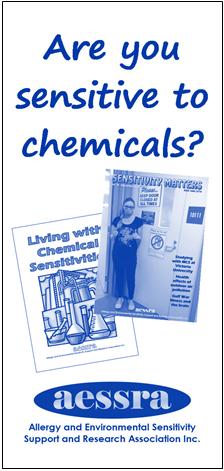What is chemical sensitivity?
People who are sensitive to a chemical get symptoms from exposure to low levels of that chemical - levels that do not cause symptoms in most people. For example, being near cigarette smoke or perfume or car exhaust may give someone sensitive to chemicals asthma or a headache. It is like an allergy, in that people react to things that don't affect other people, but the biological mechanisms are different.
How common is it?
A 2018 study found that 6.5% of Australian aged 18-65 had been told by a doctor or health professional that they had MCS. That’s slightly more than 1 in 15. 18.9% reported sensitivity to everyday chemicals such as those in household cleaning products, paints, perfumes, detergents and insect spray.(1)
What is Multiple Chemical Sensitivity?
People with Multiple Chemical Sensitivity (MCS) are sensitive to many chemicals and have symptoms in more than one organ system. MCS ranges in severity from mild to extreme.
The 1999 Consensus Statement criteria for Multiple Chemical Sensitivity (MCS) are:
- The symptoms are reproducible with (repeated chemical) exposure.
- The condition is chronic.
- Low levels of exposure (lower than previously or commonly tolerated) result in manifestations of the syndrome.
- The symptoms improve or resolve when the incitants are removed.
- Responses occur to multiple chemically unrelated substances.
- Symptoms involve multiple organ systems.(2)
What are the symptoms?
Chemical sensitivities can cause many symptoms. These include dry or sore eyes, headaches including migraines, fatigue, asthma, shortness of breath, rhinitis, blocked nose, sinus pain, sore throat, earaches, nausea, bloating, diarrhoea, constipation, poor concentration, confusion, memory problems, depression, anxiety, hyperactivity, sleep disturbance, joint pain, muscle pain, eczema and rashes.
What are people with MCS sensitive to?
Chemicals that commonly cause symptoms include car exhaust, diesel fumes, perfume, aftershave, air freshener, fragrances, washing powders, chlorine, polyester, formaldehyde, foam, plastics, rubber, pesticides, insecticides, herbicides, mothballs, disinfectants, paints, solvents, gas, newsprint, cigarette smoke, wood smoke, artificial colourings, flavourings, preservatives and other food additives.
The majority of people with MCS also have food sensitivities. Many are sensitive to various terpenes produced by plants, eg limonene. Allergies to moulds, dust mite or pollen are common. Some are sensitive to sunlight (photosensitivity) or electro-magnetic radiation.
What causes chemical sensitivity?
People can become sensitive to chemicals after a major toxic chemical exposure or after long-term, low-level exposure to toxic chemicals, eg pesticides. Chemical sensitivity can also occur after a virus or other illness, or with hormonal disturbances, eg during or after pregnancy.
A number of genes have been linked to MCS. People with mast cell disorders can be sensitive to chemicals. People with allergic conditions such as hayfever or asthma seem to be more likely to be sensitive to chemicals.
How is chemical sensitivity diagnosed?
Doctors test for chemical sensitivity with sublingual drops, intradermal injections and/or exposure in a booth. Immune tests often show abnormalities. Food sensitivities are usually tested for with an elimination diet and food challenges with single foods.
How is chemical sensitivity treated?
The main treatment is to avoid the chemicals and other substances that cause symptoms. Depending on how severe the problem is, this may involve:
- Changing to more natural and non-toxic personal care products, cleaning products, clothing, bedding and furniture
- Removing products that people are sensitive to, such as carpet or particleboard furniture, from the home
- Using non-toxic methods to control pests
- Building or renovating using non-toxic or less-toxic building materials
- Moving to a less polluted area
- Using an effective air purifier and/or water filter
- Avoiding foods that testing has shown to cause symptoms
- Eating organic food
- Lifestyle changes to reduce chemical exposures
Workplaces, schools, hospitals and other places can be made safer for people with chemical sensitivities. Chemical sensitivity is considered a disability for the purposes of the Disability Discrimination Act. The Australian Human Rights Commission included a section on improving access for people with chemical sensitivities in Access to buildings and services: Guidelines and information, updated April 2008: https://www.humanrights.gov.au/sites/default/files/content/disability_rights/buildings/good/Guidelines.doc
Some nutritional supplements and other treatments can be helpful to people with chemical sensitivities, but they are not a substitute for avoiding toxic chemicals.
What is the prognosis?
Many people can become free of symptoms by reducing exposure to chemicals they are sensitive to. MCS is worsened by continued exposure to toxic chemicals and improves with long term reduction in exposure, so the degree of sensitivity can change over time. A few people make a full recovery and are no longer affected by low levels of chemicals. It is extremely rare to die of MCS.
(1) Steinemann A. 2018. Prevalence and effects of multiple chemical sensitivities in Australia. Preventive Medicine Reports 10:191-194; doi:10.1016/j.pmedr.2018.03.007.
(2) 1999. Multiple Chemical Sensitivity: A 1999 Consensus. Archives of Environmental Health: An International Journal 54:147-149; doi:10.1080/00039899909602251.
© AESSRA Inc. 2008, 2016, 2018

This information is available on an A4 brochure you can print (printed copies are available to Australian residents):
Are you sensitive to chemicals? brochure 2018
Further information
AESSRA Inc. is not responsible for the content of websites linked to from its site.
Ashford NA, Miller CS, Chemical Exposures: Low Levels and High Stakes. Second edition.
Australian Government Department of Health and Ageing A Scientific Review of Multiple Chemical Sensitivity: Identifying Key Research Needs Report prepared by the National Industrial Chemicals Notification and Assessment Scheme (NICNAS) and the Office of Chemical Safety and Environmental Health (OCSEH) November 2010
Canadian Human Rights Commission:
The Medical Perspective on Environmental Sensitivities by Margaret E. Sears (M.Eng., Ph.D.)
Independent Living Research Utilization:
Understanding & Accommodating People with Multiple Chemical Sensitivity in Independent Living by Pamela Reed Gibson, PhD., James Madison University
Steinemann
A. 2018. Prevalence and effects of multiple chemical sensitivities in
Australia. Preventive Medicine Reports 10:191-194;
doi:10.1016/j.pmedr.2018.03.007.
Allergy and Environmental Sensitivity Support and Research Association Inc.
Reg. No. AOOO 6141S ABN 32 386 589 943
?